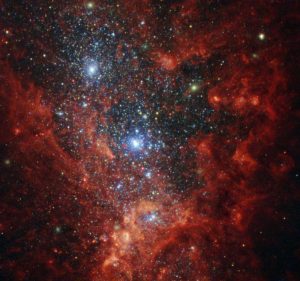NGC 1569, una galassia starbust
 Questa immagine del telescopio Hubble rivela l’interno di una delle galassie più attive nelle nostre vicinanze, NGC 1569, una piccola galassia situata a circa undici milioni di anni luce di distanza nella costellazione della Giraffa.
Questa immagine del telescopio Hubble rivela l’interno di una delle galassie più attive nelle nostre vicinanze, NGC 1569, una piccola galassia situata a circa undici milioni di anni luce di distanza nella costellazione della Giraffa.
Questa galassia è attualmente un focolaio di vigorosa formazione stellare. NGC 1569 è una galassia starburst, il che significa che è ricca di stelle e attualmente le produce ad un tasso molto più elevato di quello osservato nella maggior parte delle altre galassie. Per quasi 100 milioni di anni NGC 1569 ha formato stelle almeno 100 volte più velocemente rispetto alla Via Lattea. Di conseguenza, questa galassia brillante è sede di superammassi stellari, tre dei quali sono visibili in questa immagine, uno dei due ammassi brillanti è in realtà la sovrapposizione di due ammassi massicci. Questi ammassi, ciascuno contenente più di un milione di stelle, risiedono all’interno di una grande cavità di gas scolpita da molteplici supernove.
Nel 2008 Hubble ha osservato il ricco nucleo della galassia e le periferie esterne scarsamente popolate. Individuando singole stelle giganti rosse, l’Advanced Camera for Surveys a bordo di Hubble ha permesso agli astronomi di calcolare una nuova e molto più precisa stima per la distanza di NGC 1569. Si è così scoperto che la galassia è in realtà una volta e mezzo più lontana di quanto si pensasse, ed è parte del gruppo di galassie IC 342 .
Gli astronomi pensano che IC 342 sia responsabile dell’intensa formazione stellare osservata in NGC 1569. Si ritiene che le interazioni gravitazionali tra questo gruppo di galassie stiano comprimendo il gas all’interno di NGC 1569. Quando viene compresso, il gas collassa, si riscalda e porta alla formazione di nuove stelle.
[ Barbara Bubbi ]
https://www.spacetelescope.org/images/potw1626a/
Credit: ESA/Hubble & NASA, Aloisi, Ford
Lascia un commento